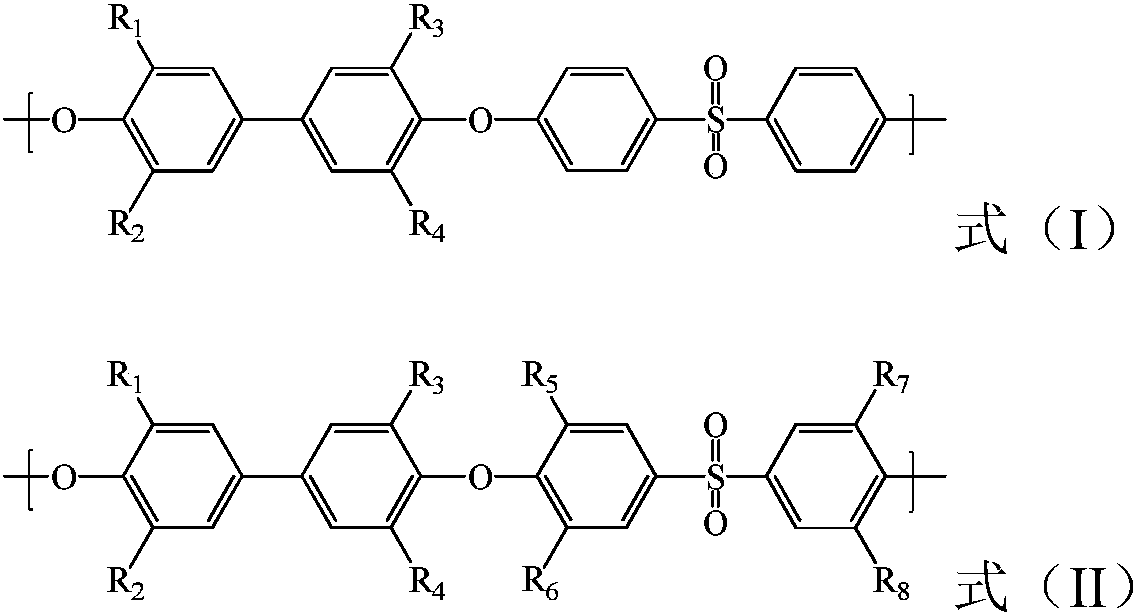Reverse osmosis membrane, preparation method and applications thereof
A reverse osmosis membrane, R1-R4 technology, applied in the field of reverse osmosis membrane and its preparation, can solve the problems of illegality and poor chlorine resistance
- Summary
- Abstract
- Description
- Claims
- Application Information
AI Technical Summary
Problems solved by technology
Method used
Image
Examples
preparation example Construction
[0030] The present invention also provides a method for preparing a reverse osmosis membrane, the method comprising: in the presence of a photoinitiator, crossing sulfonated polyethersulfone having a structure shown in formula (I) and a structure shown in formula (II) Combined to form a separation layer;
[0031]
[0032] Among them, R 1 -R 4 Each is independently H or C1-C4 alkyl, and R 1 -R 4 Not H at the same time; R 5 -R 8 Each independently is H or -SO 3 M, and R 5 -R 8 Not H at the same time, M is an alkali metal.
[0033] In the present invention, the above-mentioned sulfonated polyethersulfone is not particularly limited, and various sulfonated polyethersulfones used in the separation layer of reverse osmosis membranes in the field can be used.
[0034] According to a preferred embodiment of the present invention, R 1 -R 4 each independently is H or methyl, and R 1 -R 4 not simultaneously H; preferably, R 1 -R 4 Both are methyl.
[0035] According to a...
Embodiment 1
[0067] 1.0 g of dried sulfonated polyarylethersulfone (ion exchange capacity: 1.98 mmol / g) and 0.2 g of benzophenone were dissolved in a mixed solvent composed of 100 g of formic acid, ethylene glycol monomethyl ether and deionized water. The bisphenol A polysulfone support layer was fixed on a glass plate, and the prepared coating solution was evenly brushed on the surface of the support layer, and then heat-treated at 70°C for 10 minutes to obtain an initial composite reverse osmosis membrane. Then put the initial membrane into a UV box with a wavelength of 254nm for 5 minutes and take it out to obtain a cross-linked sulfonated polyarylethersulfone composite reverse osmosis membrane (N1) with a separation layer thickness of 185nm.
Embodiment 2
[0069] 0.75 g of dried sulfonated polyarylethersulfone (ion exchange capacity: 1.16 mmol / g) and 0.0075 g of benzophenone were dissolved in a mixed solvent composed of 100 g of formic acid, ethylene glycol monomethyl ether and deionized water. The bisphenol A polysulfone support layer was fixed on a glass plate, and the prepared dilute coating solution was evenly brushed on the surface of the support layer, and then heat-treated at 50°C for 15 minutes to obtain an initial composite reverse osmosis membrane. Then put the initial membrane into a UV box with a wavelength of 254nm for 5 minutes and take it out to obtain a cross-linked sulfonated polyarylethersulfone composite reverse osmosis membrane (N2) with a separation layer thickness of 155nm.
PUM
| Property | Measurement | Unit |
|---|---|---|
| Thickness | aaaaa | aaaaa |
| Thickness | aaaaa | aaaaa |
| Thickness | aaaaa | aaaaa |
Abstract
Description
Claims
Application Information
 Login to View More
Login to View More - R&D
- Intellectual Property
- Life Sciences
- Materials
- Tech Scout
- Unparalleled Data Quality
- Higher Quality Content
- 60% Fewer Hallucinations
Browse by: Latest US Patents, China's latest patents, Technical Efficacy Thesaurus, Application Domain, Technology Topic, Popular Technical Reports.
© 2025 PatSnap. All rights reserved.Legal|Privacy policy|Modern Slavery Act Transparency Statement|Sitemap|About US| Contact US: help@patsnap.com



